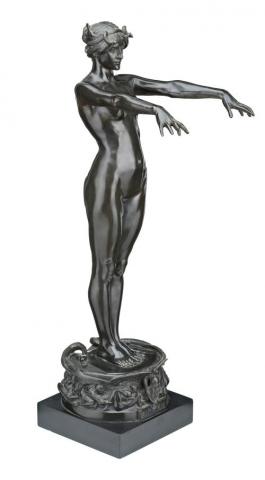CIRCE, c.1902-04
Bertram Mackennal
bronze
57.0 cm height
inscribed on base: KIP KH B MACKENNAL
Private collection, Melbourne
Deutscher Fine Art, Melbourne
Private collection, Melbourne
Another statuette of Circe was included in Bertram Mackennal: The Fifth Balnaves Sculpture Project, Art Gallery of New South Wales, Sydney, 17 August – 4 November 2007; National Gallery of Victoria, Melbourne, 30 November 2007 – 24 February 2008
References to Mackennal's Circe are too numerous to list. For the most recent see, Edwards, Deborah, et. al., Bertram Mackennal, Art Gallery of New South Wales, Sydney, 2007, pp. 30 (illus. another example), 31–4, 168–71, 211 (illus. detail), and catalogue in accompanying CD–ROM
Circe, 1893, bronze, Paris 1901, 240.0 x 79.4 x 93.4 cm, National Gallery of Victoria, Felton Bequest, 1910
Circe (statuette, c.1902–04), bronze, 57.0 x 27.0 x 21.8 cm, Art Gallery of New South Wales, Sydney
Circe, Salome and other femmes fatales captured the creative minds of many writers, artists and composers of the fin-de-siècle, and were a popular subject with the Symbolists. There was Medea, Cleopatra, Mallarmé's Hérodiade, Gustave Moreau's The Apparition, Franz von Stuck's The Sphinx, and Edvard Munch's The Vampire. Wagner's operas were heavily populated with such ladies, Rimsky-Korsakov composed his symphonic suite Schéhérazade in 1888, and Wilde, Beardsley and Strauss produced their own Salomes. Others, like Klimt, indulged in the sexually provocative Judith, and Delilah and the Sirensall had their day. Significantly, one of the most popular paintings in the Art Gallery of South Australia today is J. W. Waterhouse's Circe Invidiosa, pointing to ongoing interest in such themes that fascinated our forefathers. Bertram Mackennal's Circe is no exception, its outrageous London debut adding to its popularity and encouraging the production of an edition of statuettes. Symbolist interests were also embraced by Mackennal's Australian expatriate friends like Bunny with his witches, images of death, and mer folk, and Longstaffin his huge painting The Sirens of 1892, in the National Gallery of Victoria.
Mackennal's life-sized Circe, centrally placed in the 1893 Paris Salon, gained an honorable mention and highly favourable reviews, followed by controversy when shown atLondon's Royal Academy in 1894. Noted for its blend of French and British aesthetics, technical excellence and invention, it established his European reputation. Writers of the time commented on its 'distinctive individuality'. The critic for the Revue des Deux Mondes, remarked - 'The tense, restrained, but triumphant beauty of the sorceress bears itself with a firm and elegant alertness which is free from all trace of vulgarity and all suggestion of the model.' While, on the other side of the Channel, it was 'the irresistible supremacy of her nudity' and an expression 'of scorn for her victims' that attracted attention.1 A supremely Symbolist work, more recent writers have commented on its 'absolute embodiment of female sexuality and power'.2 Its brilliant combination of naturalism and symbolism shows Mackennal in full command of his creativity.
Derived from Homeric myth, Circe is the unrivalled female temptress whose hypnotic beauty ensnares men and turns them into swine, a universal comment on the animal nature of man. Part of the fascination of Mackennal's interpretation lies in its blend of confronting sexuality, beguiling beauty and arresting power. The life-sized Circe was cast in bronze in Paris in 1901 and acquired by the National Gallery of Victoria in 1910 through the Felton bequest. The statuettes were cast in bronze in Paris between 1902 and 1904.
1. Quoted in Jope-Slade, R, 'An Australian Quartette', The Magazine of Art, London, 1895, vol.18, p. 390
2. Read, Benedict, 'Introduction', p. 11, and Lane, Terence, 'An Homeric goddess for the modern age: Circe 1893', p. 171, in Edwards, op.cit.
DAVID THOMAS
